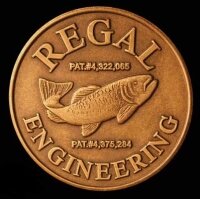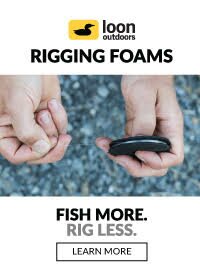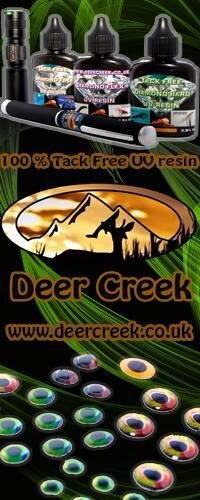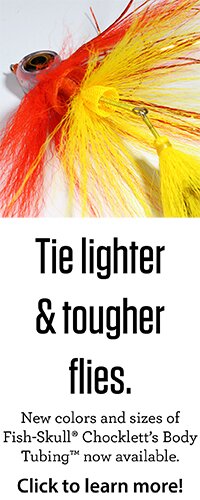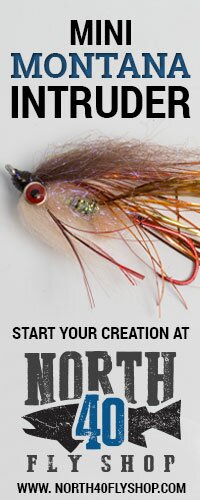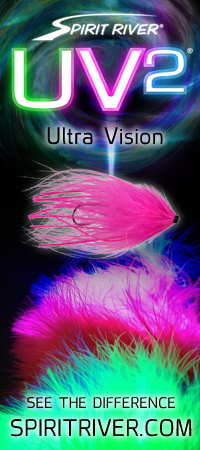
Herman Botes is an experienced South African fly tyer and he sent me some quality photos and several of his fly patterns. You might have seen or heard about his Papa Roach somewhere before. It has become a very popular fly. But his other flies should not be overlooked.

Herman Hamer
Hook – # 14 light wire scud . Gamakatsu C12
Thread – Cream or yellow . Danville 70
Post – Flouro red Antron yarn
Hackle – 4-5 turns Brown Saddle hackle
Shuck – Dubbing fibres
Abdomen – Light yellow UV Ice dubbing & light yellow SLF fibres
Rib – Tying thread
Thorax – Spiky brown dubbing
Yip, its cheesy sticking your name to a tied variation of an infamous original likes the Klinkhamer. However, this specific pattern is so devastatingly successful that I just couldn’t help myself. I’m a hatch junkie of the highest order and autumn &
early spring will find me chasing BWO & PMD hatches in order to go one-on-one with difficult surface feeding fish. The challenge & defeats that these fish bring to the game is what draws me back time after time for another round. I had similar
challenges during the dusk hatches of the 3 smaller hydroschycidae species until this game changer made it on the scene. Unlike the mayfly hatches where you go through a lot of fly changes in order to find the correct stage of emergence /
footprint, this pattern distilled this caddis hatch into a single fly affair. The pattern even has the ability to turn shallow feeding fish into free risers and my biggest yellow of 9 lb’s was taken while prospecting likely lies at the onset of a hatch. This patterns dressing deviates from the Klinkhamer , because the scruffy dubbing prevents the abdomen from penetrating well below the surface film, creating a footprint somewhere between a Klinkhamer and a Parachute. There’s no pretty little extras or triggers to the pattern, which after all looks like a mess suspended below a parachute. I guess it falls in line with Charlie Craven’s apt description of caddis pupae which he calls the ugliest bugs in the fly fishing world – a cross between something that smashed into your windscreen and a ball of snot.

Trike
Hook – # 14 1 X short . Gamakatsu S10 2S
Thread – Black Danville 70
Tail – Brown cock hackle
Abdomen – Pale yellow nylon ‘floss’
Rib – Black tying tread
Thorax – Bronze peacock Ice Dub
Legs – Brown cock hackle palmered & trimmed
Wingcase – Amber Medallion Sheeting
Head – Rootbeer 11/0 Glass Bead
The big 3 may species on the Vaal catchment are BWO’s, PMD’s (actually a Baetis) & Trico’s. Unlike the states where trico’s are # 22 and smaller , our species are #16/14 and I’ve discovered nymphs as large as #12 in some of the smaller tributaries. This stout nymph, with its robust thorax, proud legs and arched back, captures the imagination of local tiers and we are constantly tweaking and testing patterns to solve the mystery surrounding the hatch. I don’t know of any pattern that has been significantly more successful during the trico migration than old faithful – the scruffy GRHE. That however does not stop us from continuing to come up with a hatch buster.
The TRIKE ( pet name for Tricorythidae) is my current pattern in its process of evolution. It incorporates a lot of the latest trends in tail water may nymphs imitations, like slim profiles, realism, lotsa flash & mercury glass beads. It will probably change some more in the future – it’s the nature of a fly tier.

Cartoon Caddis
Hook – # 10 scud hook
Thread – Chartreuse . Danville 70
Rib – 4x mono
Shellback – Vinyl Scudback
Abdomen – caddis green Ice Dub & chartreuse Superbright dubbing blend
Legs – Shredded Spanflex
Thorax – Brown thread
Head – Brown/Copper Tungsten 3 / 3.5 / 4 mm
Weight – 14 wraps 0.25 mm
I started fishing Marcostemum Capense larval imitations in the late nineties when articles of Keith Wellington encouraged a more imitative approach to fly fishing on the Vaal River. Naturally the big caddis imitation was the weighted fly in our truck & trailer rig. The tungsten, lead & slim profile evolved over time as Euro nymphing made bigger impacts on the way we approached our nymphing. This imitation follows the ‘KISS’ principal except for the legs which I added more for myself than the fish. I am of the opinion that as fly tiers we tie patterns as much for ourselves as for the fish.
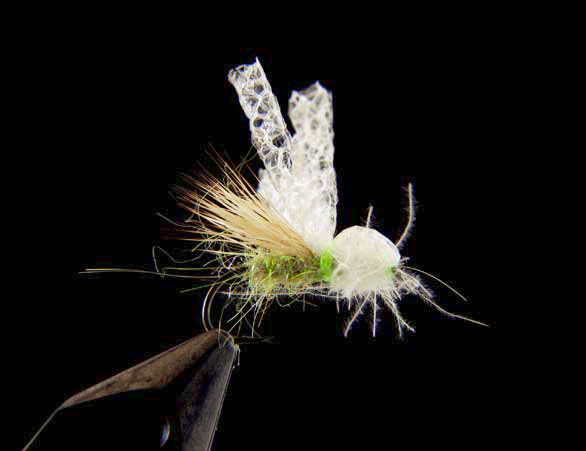
Morphed Airhead
Hook – # 10 Dry fly hook
Thread – Chartreuse Danville 70
Head And Wing – Thin white packaging foam
Abdomen – Light olive SLF & caddis green Diamond Bright dubbing blend
Wing – Bleached Elk hair
Head – CDC dubbing – light colour
Rib – Tying thread
This pattern started out as and a Gary la Fontaine original, called the Airhead, but over time morphed into its current state. The Airhead was well accepted by fish during the mating flight of Macrostemum Capense , which takes place at dusk, but I also wanted the pattern to be effective during daytime as a searching pattern. During late summer caddis moths end up on the surface as frequently as terrestrials and the pattern draws up fish with surprising regularity. The only problem was that the double layer of foam on the Airhead was just too much for the fish to stomach in the smooth surfaced heads & glides. My first change to the original was to tie it without the bottom foam strip and to dub the head with CDC. This is a similar change also made by Roman Moser to his killer pattern, the Balloon Caddis. I was happy with the patterns performance until reading Charlie Cravens comment on the reasons behind the design of his Mugly Caddis. By adopting Charlie’s messy design for the dubbed abdomen, the pattern can be fished as an emerger (clip the foam wings shorter), adult or spent cripple. The final result is a high-viz pattern with that “O crap, I’m in trouble” impression which fish find so irresistible.

Papa Roach
Hook – : # 6 wet fly / 1x short hook
Thread – Olive . Danville 70
Abdomen – olive Grizzly Zonker
Thorax/Heart – Olive UV Ice dub
Wingcase – 2 x 2 olive Mallard flank feathers
Eyes – Large black plastic bead chain
Legs – Olive Flexifloss or Spanflex
Head – Dubbing to match abdomen
That’s pretty much the status of this pattern. I guess this is my signature pattern, because of its popularity. I created this unique dragonfly nymph pattern over a 2 year period and published it in the Complete Flyfisherman in August 2004. During my excursions to stillwaters I’ve had good success with my pattern, but it turned out fellow fly fishers has had stupendous success with this fly. The list of 10 lb plus stillwater trout, which have already been taken in different locales during this patterns short existence, is freaky to say the least. The fact that I’m continually turning out a steady number of patterns for fellow fly fishers is confirmation of the fly’s success.
It’s a fast tie as far a dragon nymphs are concerned and a few fly shops in JHB carry them in their fly bins. The commercial ties are completely wrong and based on these examples I’ll lay down a few ground rules regarding this pattern.
1. Use LARGE black plastic bead chain eyes – the BIG head is 1/5 of total body
length.
2. Use standard wet or 1x short # 6 hook to tie the pattern – the fly is basically
an extended body pattern, with the hook acting as a keel. Don’t worry about short
takes – the fly is not meant to be stripped.
3. The thorax /wing case feathers must be tied in a tent like style that sheaths
and control the zonker fur strip – this is the unique style & tying step that sets
the pattern apart.
4. All the material & parts (with the exception of the head’s dubbing) is placed
ABOVE the hook shank, so the shank forms the flat base of the fly.
5. Select a Grizzly (contains guard hairs) Zonker strip with short fur fibers – remember
this is your abdomen already done & dusted.
6. NO, it is not tied in any other size – if you want to fish a smaller pattern, you
can pick from a host of other dragon patterns.
7. ALWAYS fish this pattern connected with a loop knot to the tippet and a slow
retrieve.
8. Remember this pattern look a whole lot better suspended in the water than in
your vise.
Lastly – stick to 10lb fluoro and hold on!











 I recently had the pleasure of speaking to entomologist, fly tyer, and fly fisherman Dave McNeese. When Dave was young he traveled to New York to spend time with fly tyers like Art Flick, Elsie Darbee, Ray Smith, and Roy Steenrod. He has been doing scientific study on fish and insects since 1963. Dave has been instrumental in the study of the effect of UV products for fly tyers and is an expert in dying materials. He’s helped Bill Black of Spirit River tremendously with their UV2® line of fly tying materials. To read more about Spirit River UV2®, read my
I recently had the pleasure of speaking to entomologist, fly tyer, and fly fisherman Dave McNeese. When Dave was young he traveled to New York to spend time with fly tyers like Art Flick, Elsie Darbee, Ray Smith, and Roy Steenrod. He has been doing scientific study on fish and insects since 1963. Dave has been instrumental in the study of the effect of UV products for fly tyers and is an expert in dying materials. He’s helped Bill Black of Spirit River tremendously with their UV2® line of fly tying materials. To read more about Spirit River UV2®, read my  Some UV materials can be used sparingly, like Spirit River’s UV2® Enhancer. When working with Enhancer it’s best to mix small amounts into some natural dubbing or mix it with natural fur like beaver or otter for example. You have to keep in mind that the entire body of a mayfly does not glow. Only small parts will have a UV reflective aspect to them. This is why you should only need a small amount mixed in instead of using only the UV2® Enhancer by itself. Spirit River does have their own UV2® dubbing mixes that have a mix of 15 to 30% UV2® already in them.
Some UV materials can be used sparingly, like Spirit River’s UV2® Enhancer. When working with Enhancer it’s best to mix small amounts into some natural dubbing or mix it with natural fur like beaver or otter for example. You have to keep in mind that the entire body of a mayfly does not glow. Only small parts will have a UV reflective aspect to them. This is why you should only need a small amount mixed in instead of using only the UV2® Enhancer by itself. Spirit River does have their own UV2® dubbing mixes that have a mix of 15 to 30% UV2® already in them.









